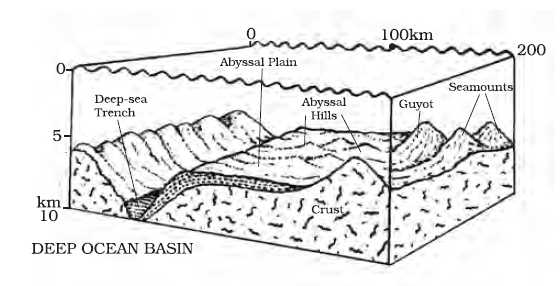-
11 Jan 2025
GS Paper 1
Geography
Day 36: Discuss the major features of the ocean floor and their impact on ocean currents. (150 Words)
Approach:
- Briefly introduce the ocean floor's topography and its importance in influencing ocean currents.
- In the body, discuss major ocean floor features and their impact on ocean currents, with examples.
- Conclude suitably.
Introduction:
The ocean floor is a diverse and dynamic landscape, comprising features like continental shelves, mid-ocean ridges, trenches, and abyssal plains. These features interact with ocean currents, influencing their direction, intensity, and patterns. This interplay is critical for regulating global climate, distributing nutrients, and sustaining marine ecosystems.
Body:
Major Features of the Ocean Floor:
- Continental Shelves:
- Shallow, gently sloping regions extending from coastlines to the continental slope.
- They are rich in marine biodiversity and play a key role in coastal ocean processes.
- Abyssal Plains:
- Flat, deep-sea areas located between 3,000 to 6,000 meters below sea level.
- They cover large portions of the ocean floor and are composed of sediments from land and marine organisms.
- Mid-Ocean Ridges:
- Underwater mountain ranges formed at divergent tectonic plate boundaries.
- These ridges are sites of volcanic activity and seafloor spreading.
- Oceanic Trenches:
- Deep, narrow depressions formed at subduction zones where one tectonic plate is forced beneath another.
- Trenches are the deepest parts of the ocean, with depths exceeding 8,000 meters.
- Seamounts and Guyots:
- Seamounts are underwater volcanic mountains, while guyots are flat-topped seamounts eroded over time.
- These features are scattered throughout the ocean and provide habitats for marine life.
- Submarine Canyons:
- Steep, V-shaped valleys carved into the continental slope, often extending from river systems.
Impact on Ocean Currents:
- Continental Shelves:
- Facilitate upwelling and downwelling, driving nutrient transport and supporting marine ecosystems.
- Example: The Peruvian Shelf enhances upwelling, supporting one of the world's richest fisheries.
- Abyssal Plains:
- Provide smooth pathways for deep-water currents like the North Atlantic Deep Water, which transports cold, dense water across ocean basins.
- This aids in global thermohaline circulation, balancing ocean heat.
- Mid-Ocean Ridges:
- Disrupt and deflect ocean currents, influencing their paths.
- They drive vertical water movement, promoting mixing between surface and deep layers.
- Example: The Mid-Atlantic Ridge contributes to the Atlantic Meridional Overturning Circulation (AMOC).
- Oceanic Trenches:
- Redirect and funnel deep-water currents, impacting the global conveyor belt circulation.
- Example: The Mariana Trench channels cold water into the ocean's deep layers, supporting thermohaline flow.
- Seamounts and Guyots:
- Disrupt current flow, creating eddies that enhance nutrient mixing and marine biodiversity.
- Example: The Emperor Seamount Chain in the Pacific generates turbulence, enriching local ecosystems.
- Submarine Canyons:
- Channel sediment-laden turbidity currents, contributing to deep-sea nutrient transfer.
- Influence localized current systems and support benthic marine habitats.
Conclusion:
The ocean floor's topography significantly shapes the movement and behavior of ocean currents, influencing global heat distribution, nutrient cycling, and marine biodiversity. Understanding this interdependence is crucial for managing climate systems and conserving marine resources.





